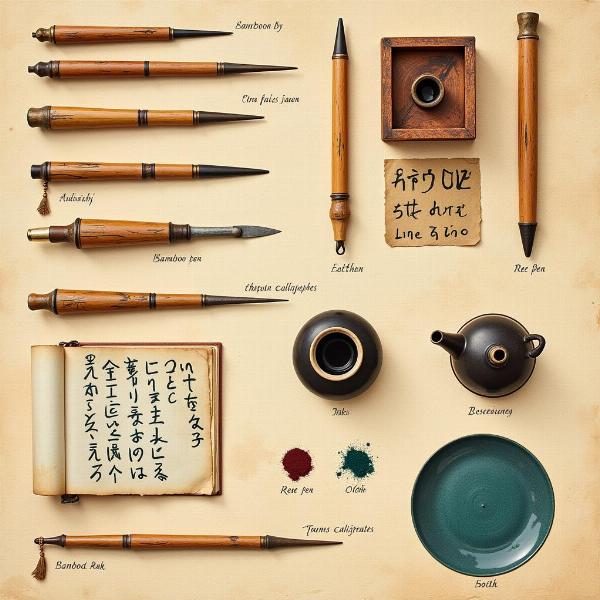Calligraphy, the art of beautiful handwriting, holds a special significance in many cultures, including India. If you’re wondering “what is the meaning of calligraphy in Hindi,” you’ve come to the right place. This article explores the meaning, history, and cultural importance of calligraphy in the Hindi language and the broader Indian context. We’ll delve into the various scripts, styles, and tools used, and examine how calligraphy continues to thrive in the digital age.
Understanding the Essence of Calligraphy in Hindi
The Hindi word for calligraphy is सुलेख (sulekh), literally meaning “good writing” or “beautiful writing.” This term encompasses the aesthetic value placed on the written word in Indian culture. Sulekh is not just about legibility; it’s about artistry, precision, and the expression of emotions and ideas through the strokes of a pen or brush. It represents a deep respect for language and its ability to convey meaning beyond the words themselves. Just as a musician uses notes to create music, a calligrapher uses letters to create visual harmony and beauty. This art form transcends mere communication, becoming a meditative practice and a powerful form of artistic expression.
 Hindi Calligraphy Tools and Materials
Hindi Calligraphy Tools and Materials
A Journey Through the History of Hindi Calligraphy
The history of calligraphy in India is intertwined with the development of its scripts, primarily Devanagari, the script used for Hindi. From ancient inscriptions on stone to medieval manuscripts on palm leaves and paper, calligraphy has played a crucial role in preserving and disseminating knowledge, religious texts, and literature. The evolution of different calligraphy styles reflects the changing cultural and artistic landscapes of India. Each stroke, curve, and ligature tells a story of the past, showcasing the dedication and skill of the calligraphers who shaped the written word.
Exploring the Various Styles and Scripts
Hindi calligraphy encompasses various styles, each with its unique characteristics. From the elegant curves of the Devanagari script to the more stylized forms used in religious texts and artistic creations, there’s a rich diversity to explore. The choice of script and style often depends on the purpose of the calligraphy, whether it’s for a formal document, a religious inscription, or a piece of art. Some common styles include the traditional “Devanagari Lipi” and more contemporary adaptations influenced by other calligraphic traditions.
Calligraphy Tools and Techniques
Traditional Hindi calligraphy often involves the use of bamboo or reed pens dipped in ink. The angle of the pen, the pressure applied, and the speed of the stroke all contribute to the final form of the letters. Mastering these techniques requires patience, practice, and a keen eye for detail. While modern tools like calligraphy markers and pens are available, the traditional methods continue to be cherished for their authenticity and connection to the rich heritage of Hindi calligraphy.
Calligraphy in the Digital Age
Even in the digital age, calligraphy maintains its relevance and charm. Digital calligraphy tools and software allow for greater experimentation and accessibility. While the tactile experience of traditional calligraphy is unique, digital tools offer new avenues for creativity and expression. They also make it easier to share and appreciate this art form with a wider audience.
Conclusion
Calligraphy, or सुलेख (sulekh), is more than just beautiful handwriting; it’s an art form deeply rooted in Indian culture. It’s a celebration of the written word, a testament to the power of language, and a reflection of India’s rich artistic heritage. Whether using traditional tools or embracing digital innovations, calligraphy continues to inspire and captivate, preserving the beauty of the Hindi language for generations to come. What is the meaning of calligraphy in Hindi? It is the art of beautiful writing, but more than that, it is the embodiment of cultural heritage and artistic expression.
FAQ
- What is the Hindi word for calligraphy? The Hindi word for calligraphy is सुलेख (sulekh).
- What are some common tools used in Hindi calligraphy? Traditional tools include bamboo or reed pens, ink pots, and various types of paper or cloth.
- Is calligraphy still practiced in India today? Yes, calligraphy is still practiced and appreciated in India, both in traditional and digital forms.
- What is the significance of calligraphy in Indian culture? Calligraphy is valued for its aesthetic beauty and its role in preserving and transmitting knowledge and cultural traditions.
- Where can I learn Hindi calligraphy? You can find resources and classes online, or seek out local calligraphy workshops and instructors.
- What are the different styles of Hindi calligraphy? There are various styles, ranging from traditional Devanagari Lipi to contemporary adaptations.
- Can I use digital tools for Hindi calligraphy? Yes, digital tools and software are increasingly popular for creating and sharing Hindi calligraphy.
Meaning-Hindi.in: Your Partner in Language Solutions
Meaning-Hindi.in is a leading provider of Hindi translation and language services, specializing in business, legal, technical, website localization, educational, and specialized translation. Our expert linguists ensure accurate and culturally sensitive translations, bridging the gap between languages and cultures. Whether you need document translation, website localization, or interpretation services, Meaning-Hindi.in has the expertise to meet your needs. Contact us at [email protected] or +91 11-4502-7584 for all your Hindi language needs.